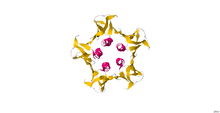Shiga-like toxin
| Shiga-like toxin beta subunit | |||||||||
|---|---|---|---|---|---|---|---|---|---|
 | |||||||||
| Identifiers | |||||||||
| Symbol | SLT_beta | ||||||||
| Pfam | PF02258 | ||||||||
| InterPro | IPR003189 | ||||||||
| SCOP | 2bos | ||||||||
| SUPERFAMILY | 2bos | ||||||||
| TCDB | 1.C.54 | ||||||||
| |||||||||
Shiga-like toxin, also known as verotoxin,[1][2] is a toxin generated by some strains of Escherichia coli (but see below).[3] It is named for its similarity to the AB5-type Shiga toxin produced by the bacteria Shigella dysenteriae, [ see Vero cell ].
There are two types, known as SLT1 and SLT2.[4]
History
Transmission
As with Shiga toxin, the toxin requires highly specific receptors on the cells' surface in order to attach and enter the cell; species such as cattle, swine, and deer which do not carry these receptors may harbor toxigenic bacteria without any ill effect, shedding them in their feces, from where they may be spread to humans.
Clinical significance
Shiga-toxin is associated with Hemolytic-uremic syndrome.
Structure and mechanism
_from_from_Escherichia_coli_O157-H7_PDB_1r4p.png)
Structure
The toxin is a multisubunit protein made up one molecule of A subunit (32,000 molecular weight) responsible for the toxic action of the protein, and five molecules of the B subunit (7,700 molecular weight) responsible for binding to a specific cell type.
Mechanism of action
The toxin acts on the lining of the blood vessels, the vascular endothelium. The B subunits of the toxin bind to a component of the cell membrane known as glycolipid globotriaosylceramide (Gb3).[5] Binding of the subunit B to Gb3 causes induction of narrow tubular membrane invaginations, which drives formation of inward membrane tubules for the bacterial uptake into the cell. These tubules are essential for uptake into the host cell.[6] When the protein is inside the cell, the A subunit interacts with the ribosomes to inactivate them. The A subunit of Shiga toxin is an N-glycosidase that modifies the RNA component of the ribosome to inactivate it and so bring a halt to protein synthesis leading to the death of the cell. The vascular endothelium has to continually renew itself, so this killing of cells leads to a breakdown of the lining and to hemorrhage. The first response is commonly a bloody diarrhea. This is because Shiga toxin is usually taken in with contaminated food or water.
The toxin is effective against small blood vessels, such as found in the digestive tract, the kidney, and lungs, but not against large vessels such as the arteries or major veins. A specific target for the toxin appears to the vascular endothelium of the glomerulus. This is the filtering structure that is a key to the function of the kidney. Destroying these structures leads to kidney failure and the development of the often deadly and frequently debilitating hemolytic uremic syndrome. Food poisoning with Shiga toxin often also has effects on the lungs and the nervous system.
Source of toxin gene
It has been suggested by some researchers that the gene coding for Shiga-like toxin comes from a toxin-converting lambdoid prophage, such as H-19B or 933W, inserted into the bacteria's chromosome via transduction.[7]
See also
References
- ↑ Beutin L, Geier D, Steinrück H, Zimmermann S, Scheutz F (September 1993). "Prevalence and some properties of verotoxin (Shiga-like toxin)-producing Escherichia coli in seven different species of healthy domestic animals". Journal of clinical microbiology 31 (9): 2483–8. PMC 265781. PMID 8408571.
- ↑ Bitzan M, Richardson S, Huang C, Boyd B, Petric M, Karmali MA (August 1994). "Evidence that verotoxins (Shiga-like toxins) from Escherichia coli bind to P blood group antigens of human erythrocytes in vitro". Infection and immunity 62 (8): 3337–47. PMC 302964. PMID 8039905.
- ↑ Giraldi R, Guth BE, Trabulsi LR (June 1990). "Production of Shiga-like toxin among Escherichia coli strains and other bacteria isolated from diarrhea in São Paulo, Brazil". Journal of clinical microbiology 28 (6): 1460–2. PMC 267957. PMID 2199511.
- ↑ Zhu Q, Li L, Guo Z, Yang R (June 2002). "Identification of Shiga-like toxin Escherichia coli isolated from children with diarrhea by polymerase chain reaction". Chin. Med. J. 115 (6): 815–8. PMID 12123543.
- ↑ Kaper, JB; Nataro, JP, Mobley, HL (Feb 2004). "Pathogenic Escherichia coli.". Nature reviews. Microbiology 2 (2): 123–40 [129]. doi:10.1038/nrmicro818. PMID 15040260.
- ↑ Römer W, Berland L, Chambon V, et al. (November 2007). "Shiga toxin induces tubular membrane invaginations for its uptake into cells". Nature 450 (7170): 670–5. doi:10.1038/nature05996. PMID 18046403.
- ↑ Satoshi MIZUTANI, Naoki NAKAZONO, and Yoshinobu SUGINO (1999). "The So-called Chromosomal Verotoxin Genes are Actually Carried by Defective Prophages". Dna Research 6 (2): 141–143. doi:10.1093/dnares/6.2.141. PMID 10382973.
- ↑ Stein PE, Boodhoo A, Tyrrell GJ, Brunton JL, Read RJ (February 1992). "Crystal structure of the cell-binding B oligomer of verotoxin-1 from E. coli". Nature 355 (6362): 748–50. doi:10.1038/355748a0. PMID 1741063.
External links
- Shiga-Like Toxin I at the US National Library of Medicine Medical Subject Headings (MeSH)
- Shiga-Like Toxin II at the US National Library of Medicine Medical Subject Headings (MeSH)
- http://www.textbookofbacteriology.net/Shigella.html
- http://www.textbookofbacteriology.net/Shigella.html
- http://dnaresearch.oxfordjournals.org/cgi/reprint/6/2/141?ck=nck
| ||||||||||||||||||||||||||||||||||||||||||||||||||||||||||||||||||||||||||||